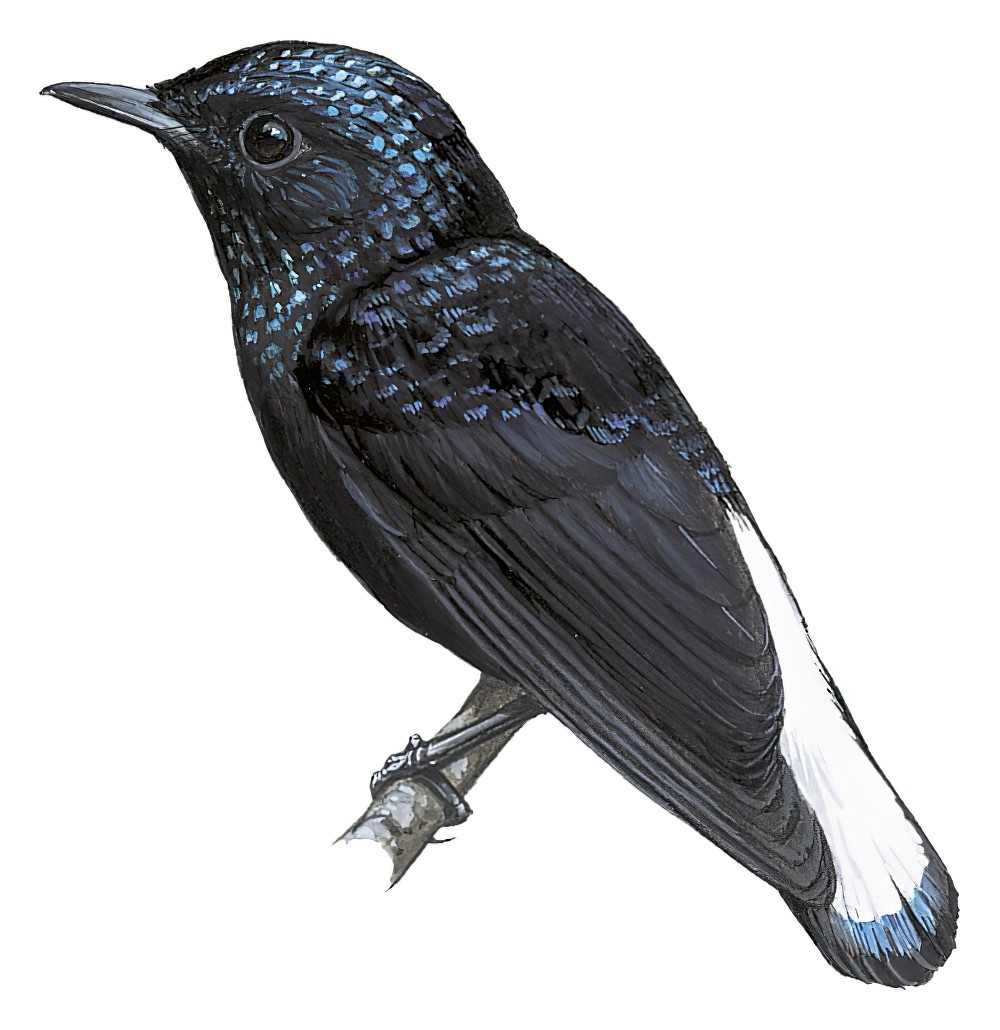Taveuni Silktail / Lamprolia victoriae

Taveuni Silktail
SCI Name:
Protonym: Lamprolia victoriae Proc.Zool.Soc.London(1873) (1873), Pt3 p.735 pl.62
Taxonomy: Passeriformes / Rhipiduridae / Lamprolia
Taxonomy Code: silkta2
Type Locality: Taveuni, Fiji.
Author: Finsch
Publish Year: 1874
IUCN Status: Near Threatened
DEFINITIONS
LAMPROLIA
(Rhipiduridae; Ϯ Taveuni Silktail L. victoriae) Gr. λαμπρος lampros brilliant, splendid; λειος leios smooth, polished; "At first sight the bird immediately proves to be new—not only as a species but also as a type of new genus, which I propose to call LAMPROLIA †, nov. gen. Diagn. gen. Bill and feet as in Saxicola, but the nostrils covered partly by the frontal feathers; wings long and rounded, with very short projecting point of primaries, as in Thamnobia; tail short, rounded; mode of coloration Paradiseine. Bill (fig. 1) moderate, straight, slender, at base broader than high; culmen subcarinated, slightly curved, and the sides gradually compressed to the tip, which is slightly emarginated; the gape furnished with a few short bristles. Nostrils basal, lateral; the opening oblong, without membrane, and partly covered by the brush-like erectile frontal feathers. Wings (fig. 3) long, rounded, reaching beyond the middle of the tail; first primary moderately short, a little longer than half of the second, which is shortened and nearly equal to the eighth; fourth and fifth quills equal and longest, third scarcely shorter; projecting point of primaries very short; quills, especially the secondaries, very broad, with rounded tips; ten primaries and nine secondaries. Tail (fig. 2) short, broad, and moderately rounded, with twelve feathers, which at the end are broad, rounded, subtruncate, and exhibit a singular concavity. Tarsi long, slender, and covered by a single scale in front (caligated), with the inner toe shorter than the outer toe, which is united at its base with the middle toe; the hind toe long, nearly equal to the middle toe, and armed with a strong, curved claw. I scarcely remember a bird which has puzzled me in respect of its generic position so much as this curious little creature. At first glance it reminds one of a Paradiseine bird by the luxuriance of its coloration and the extraordinary structure of its plumage. The feathers on the back show the singular velvet-black observed in the genus Ptilorhis, whereas the shining steel-blue tips of the feathers on the head and neck, in their scale-like appearance, resemble those of Manucodia. Quite singular are the tail-feathers as regards the loose and separated disposition of their radii, and the splendid shining silky white coloration which they show on their basal portions, like the rump and upper tail-coverts. After a careful examination I come to the conclusion that this new form ranges nearest to Pentholæa, Cab. ... Amongst Australian and Polynesian genera Petroica is the nearest ally, but easily distinguished by its long wings, with the very prominent point of the primaries, and by its long tail. ... † From λαμπρος, splendidus, and λειος, lævis. ... LAMPROLIA VICTORIÆ, Finsch, sp. nov. ... A collector's note says, "The small black bird, native name 'Kaya,' from top of mountains, Taviuni, has the habits of a perching bird or Robin; eyes dark brown." I have great pleasure in naming this most remarkable and brilliant new species Lamprolia victoriæ, in honour of Her Imperial and Royal Highness Victoria, Crown-Princess of the German Empire and of Prussia." (Finsch 1874); "Lamprolia Finsch, 1874, Proc. Zool. Soc. London (1873), p. 733. Type, by monotypy, Lamprolia victoriae Finsch." (Mayr in Peters 1986, XI, 526). The silktails, formerly of uncertain relationships and treated in a monogeneric family, may now be treated as very distinctive species allied to Chaetorhynchus and Rhipidura.
victoria / victoriae
● Victoria, Australia (named after Alexandrina Victoria Queen of Great Britain) (syn. Acanthorhynchus tenuirostris, syn. Alcedo azurea, subsp. Climacteris picumnus, syn. Colluricincla harmonica, syn. Coracina papuensis robusta, syn. Dasyornis brachypterus, syn. Drymodes brunneopygia, syn. Eurostopodus mystacalis, syn. Halobaena caerulea, syn. Ixobrychus minutus novaezelandiae, syn. Malurus splendens melanotus, subsp. Menura novaehollandiae, syn. Microeca fascinans, syn. Ninox strenua, syn. Oxyura australis, syn. Platycercus elegans, syn. Podargus strigoides, syn. Rhipidura albiscapa alisteri, subsp. Synoicus chinensis).
● Mt. Victoria (= Nat Ma Taung), Chin Hills, Burma (subsp. Aethopyga nipalensis, syn. Certhia manipurensis, subsp. Pellorneum ruficeps, subsp. Pyrrhula nipalensis, Sitta, syn. Siva strigula yunnanensis, subsp. Trochalopteron austeni).
● Alexandrina Victoria Queen of Great Britain and Empress of India (1819-1901; reigned 1837-1901) (syn. Ardea alba, Goura, Lophorina).
● Lake Victoria (= Victoria Nyanza), East Africa (syn. Cisticola chiniana fischeri, Ploceus).
● Victoria Adelaide Mary Louise Crown-Princess of Germany and Prussia (1840-1901), eldest child of Queen Victoria, and wife to Friedrich Wilhelm Crown-Prince of Germany and Prussia (Lamprolia).
● Marie Anne Victoire Mulsant née Jacquetton (1777-1854) mother of French ornithologist Martial Mulsant (Lesbia).
● Sierra La Victoria, southern Baja California, Mexico (subsp. Vireo gilvus).
UPPERCASE: current genus
Uppercase first letter: generic synonym
● and ● See: generic homonyms
lowercase: species and subspecies
●: early names, variants, mispellings
‡: extinct
†: type species
Gr.: ancient Greek
L.: Latin
<: derived from
syn: synonym of
/: separates historical and modern geographic names
ex: based on
TL: type locality
OD: original diagnosis (genus) or original description (species)












